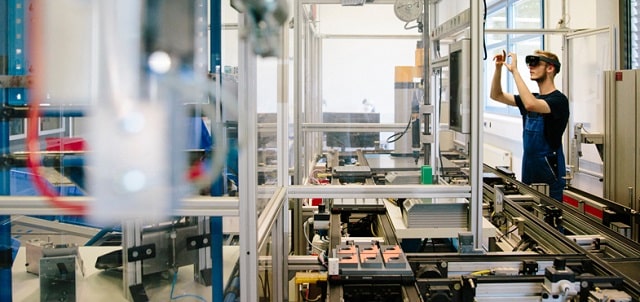
Smart production technologies are evolving at an unprecedented pace, leaving those who ignore these innovations at risk of being surpassed by their more tech-conscious competitors. Plant managers and owners are continuously looking for ways to reduce costs, increase efficiency, and improve overall productivity – all while using the same tools and equipment.
Augmented Reality (AR) is a subset of Virtual Reality (VR) that is implemented in manufacturing and plant management. The global AR market has experienced tremendous growth in recent years because it relies on existing user environments and displays virtual content over it. These technologies are designed using 3D software programs that allow developers to display digital content over the real world.
Goldman Sachs predicts that AR has “the potential to evolve into the next big computing technology. We expect existing markets to be disrupted and new markets to be created.” What exactly does this mean for automobile manufacturers and other production plants?
It means there are five new ways that you can use augmented reality technologies or machine learning in plant management and manufacturing factories.
How Augmented Reality Tech Helps Improve Plant Management
1. Factory Design
Auto manufacturers looking to expand or set up a factory have plenty to benefit from augmented reality. The planning phase can be time-consuming and costly. Owners must plan to the last details, from the tiniest light switches to the largest pieces of equipment. AR allows them to preview every detail in real-time by offering them the ability to assess their proposed factories. Various builders, engineers, architects and more can make vital contributions to the proposed designs.
Instead of relying on 2D models and other old-fashioned blueprints, augmented reality allows for a greater level of collaboration by allowing designers to make suggestions, as well as express concerns should a problem be identified. AR also offers many other benefits in the design phase, including the ability for owners to view how their production processes will take place in the new factory.
2. Automation
Repetitive tasks are crucial in manufacturing, but it’s not mandatory to have actual people perform these tasks. Manufacturers have become aware of augmented reality solutions that can adjust, monitor, and program industrial robots to do many complex and repetitive tasks. Users can program robots to perform a wide variety of tasks from various points of view. On top of this, some of these tasks can be risky, which makes automation a sensible option.
Benefits include generation of detailed reports on remaining and accomplished tasks, reduced risk to workers, ability to operate factories 24/7, and many others. These machines can then all be monitored and managed via AR. Systems such as Aircada allow for AR plant management via Scada / HMI - saving you time, effort and making your place of work safer and more efficient.
3. Automotive Assembly
A virtual auto plant goes beyond Computer Aided Design to assist engineers make crucial decisions about designs through detailed visualizations, thereby eradicating the need for a physical prototype. On top of this, AR can be employed as a tool to find and solve potential issues in assembly. This can all be implemented before the assembly has been completed, or any production process has started.
Benefits of augmented reality in auto assemblies include automated task assessment, easy testing of designs, ability to actualize the assembly process from start to finish, and many others.
4. Training On Augmented Reality
AR provides a convenient way for workers to learn new manufacturing skills without risk to individuals or property. This type of training allows workers to do everything from welding to disassembling an entire engine, all while the augmented reality system records data including, but not limited to; power used, weld quality, time for assembly, and many others.
Benefits of training using augmented reality include ability to training new workers on existing processes to allow them to learn new skills and assess how safe they are working according to information found here.
5. Car Maintenance
Augmented reality provides unique benefits to car maintenance applications. Maintenance for an entire assembly line can be simulated and planned well in advance of the set date. Workers can be familiarized with existing or new equipment before the task. Virtual car maintenance can even be done in virtual factories to evaluate its effects on normal operations.
Other benefits include offering a unique perspective, enabling trial runs, and familiarizing employees with maintenance tasks, all while being risk-free to the factory.
AR Advantages
As you can see, augmented reality technology can make a major impact at plants and factories. As time goes on AR, VR, and machine learning will take manufacturing to the next level. It is time you master your manufacturing with this new top tech!
